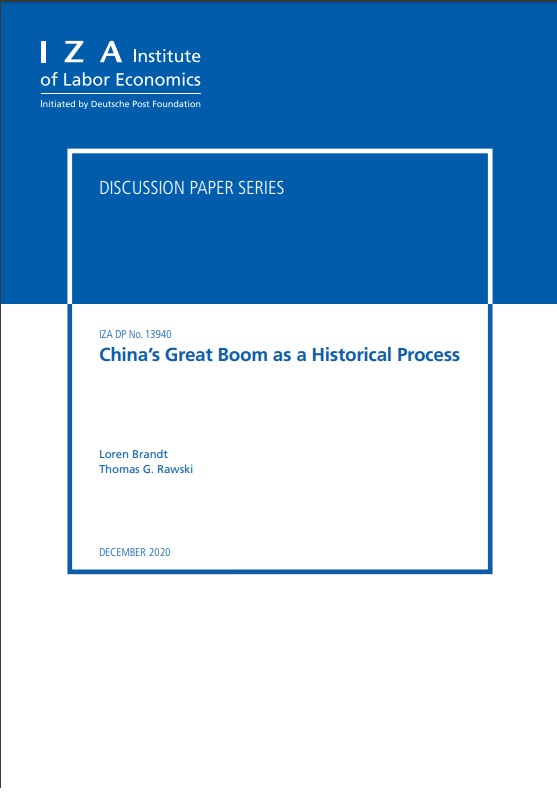Interpreting or misinterpreting China’s success

Branko Milanovic explores a new paper on China's long run growth and its implications for understanding the relationship between inequality and development.
I recently read a review of China’s long-term economic progress by two well-known scholars of Chinese economy: Loren Brandt and Thomas Rawski. I have read and cited both. Just to give some examples: I liked very much a paper on inequality in the Chinese countryside in the 1930s co-authored by Brandt; or Rawski’s work on growth (and, secondarily, on inequality) in pre-war China. As these examples show, my interest in both authors was, not surprisingly, more on what they wrote on inequality in China, not on the issues of growth and long-term development. The latter however is the topic they address in this paper (which is also a chapter in the recently published Cambridge Economic History of China vol. 2).
I thus read their new piece with great interest. Alas, I was disappointed. I will criticize the paper in two respects: first, the implicit, or at times quite explicit, narrative regarding China’s development from the end of the 19th century to today, and second, internal contradictions among the arguments made in the paper.
Brandt and Rawski (B-R) narrative can be summarized as follows. The late Qing and early Republican China, while backward in many respects, have shown the signs of a remarkable ability to quickly adopt western production and financial techniques. Coercive and discriminatory rules imposed by Western powers, Russia and Japan were in reality helpful for the Chinese development. (It is unlikely that China could have experienced this early development burst without Western semi-colonialism.) The Nanjing KMT government adopted much more pro-state policies (compared to the late Qing), although this was short-lived because of the war and internal conflict. The Maoist government when it came to power in 1949 continued KMT’s line of state-led development and made it more planified (even if it never approaching the Soviet extent of planning). Because such policies blunted the incentives, they created a huge gap between the potential and actual output. The gap was “mopped up” during Deng’s pro-market episode. The recent approach by Xi Jinping is a reversal aiming to give greater role to the state (“an inward-looking Soviet-style plan”), accompanied by a “retreat from…global cooperation.” It is very unlikely that China will be able to make technological leaps that the Party and the government promise and have made the cornerstone of their policies.
 I believe that this, hopefully fair, review of the B-R argument highlights several important points on which the authors insist. First, the quasi-colonial relations were good for China’s development (“privileges won through foreign military pressure encouraged domestic economic growth”, p. 787). Second, there was a continuum between KMT’s and Maoist policies. Third, China’s spectacular post-1978 growth is to be explained simply as a “rebound”, the clever use of the already existing capacities and capabilities.
I believe that this, hopefully fair, review of the B-R argument highlights several important points on which the authors insist. First, the quasi-colonial relations were good for China’s development (“privileges won through foreign military pressure encouraged domestic economic growth”, p. 787). Second, there was a continuum between KMT’s and Maoist policies. Third, China’s spectacular post-1978 growth is to be explained simply as a “rebound”, the clever use of the already existing capacities and capabilities.
Let me focus on these points. The principal argument for the first is the existence of economically dynamic parts, or rather cities, in the coastal region of China. B-R mention for example that Shanghai was a sleepy country seat and that its the growth rate in the Republican period was comparable to the growth rates of Japan, India and the USSR. Such examples of individual successes in a country as enormous as China (500 million people in the 1930s) are a form of cherry-picking, if they are used to claim something more than that there were a few poles of growth. One could almost at will find cities or areas that have prospered in any country in the world while that country as a whole had stagnated or even went backward. Maddison’s data on China show its GDP per capita to have increased from $985 in 1913 to $1,003 in 1938 (all in international dollars), which gives an average annual growth rate of hardly above zero. Thus, Chinese growth in the pre-war period merely kept up with the increase of population (which was about 0.6% per year). This is hardly extraordinary.
As the quote below from a survey of villages undertaken by the China Cotton Mill Owners’ Association for the purpose of estimating the demand for textiles in the 1930s shows:
[we] found disastrous conditions: women in Szechuan were not wearing skirts because the rural devastation had left farmers without the means to purchase cloth, and in many households family members shared one item of clothing (Shiroyama 2008, 127; quoted from Milanovic, Capitalism, Alone, p.80)
China, for most of its inhabitants was a land of almost unimaginable poverty and backwardness. A few entrepots’ bright lights here and there made little difference to the country as a whole. This holds even more if we believe that the lack of domestic agency (that is, the quasi colonial relationship) is a negative thing per se.
The continuation of policies between KMT and Mao’s government has been noted by many authors. It is not a new point. But in B-R it plays a paradoxical role. They aim to situate the post-1978 Chinese advances not on the basis created by Mao’s policies but very implausibly, given the short duration of the KMT government, on pre-revolutionary developments. The authors’ narrative becomes inconsistent: on the one hand, a number of glaring inefficiencies of socialist planning are rightly cited, but then the Dengist success is explained by the claim that it simply exploited the existing gap between the potential and realized output created during the Mao era. But if Mao’s era created the possibility to have a much higher output, it must have done something right. Since the authors cannot bring themselves to mention anything positive to have happened during Mao’s period we are left in a quandary as to how a thoroughly inefficient system such as Mao’s could have created the basis for Dengist revival.
B-R come to this impossible position because they tend to see the Dengist revival not so much on its own terms, to have been the greatest long-term expansion in economic history, but to treat it as, almost mechanically, filling up the gap between the possible and the actual. Thus the narrative undervalues the importance of Dengist reforms (which are not discussed in any detail), dismisses explicitly Maoist period (while indirectly acknowledging its importance), and all but explains China’s 1980-2008 successes by the Nanjing government policies.
The authors here face a real problem: in order to dismiss Deng, they need to claim that the potential for growth already existed under Mao; but they cannot credit Mao for that potential because they criticize all of his policies. Thus, somehow, that potential has to be shown to have originated in a government that lasted less than ten years, never controlled the entire territory of China, and operated in an entirely different intellectual and global environment more than half-a-century before Deng.
My last point already hints at one internal contradictions in the paper. They are many. The authors document low productivity growth of state-owned enterprises (SOEs) by, among other things, pointing to their low profitability. But they do not seem to notice that SOEs low profitability may be due to extra-economic tasks that these enterprises are supposed to fulfill, as well as to higher effective taxation. Moreover, in order to explain the Belt and Road initiative they have to acknowledge large profits of SOEs; so suddenly we read that the share of SOE profits in GDP has risen. But if SOEs profits are increasing faster than the total value added, this is hard to reconcile that with the earlier statement that low profitability of SOEs is due to their inefficiency.
B-R write with a Thatcherite glee about the industrial restructuring that took place n the 1990s (urban reforms). The employees of SOEs are “culled” (p. 809), the reforms “decanted” tens of millions of workers “into the grip of market discipline” (p. 825) at the time when companies were “bulging with surplus employees” (p 827). The dogma of efficiency which comes on the heels of privatization is so extravagant that, reading this in 2022, when in many countries the gains from privatization of existing companies have been found to be minimal (if any), the text seems slightly embarrassing and anachronic. The authors probably would not imagine using this cheerleading language if they were to describe Thatcher’s or Reagan’s policies. But this kind of language, and more importantly, the cheerful interpretation of driving out in the street thousands of middle-aged workers, seems to be de rigueur when writing of former socialist economies and China. Its costs are never mentioned.
After celebrating unemployment and “sharpness of incentives” that it brings, the authors strangely blame CPC for high inequality that “resembles” the late Qing era (p. 824). Leaving aside that their quote of 15% of total income received by the top 1 percent is highly contested (because it is based of imputing SOE profits to individuals with the highest private capital incomes—a most dubious assumption), a 15% share is still much lower than the 24% share of the top 1 percent in 1880s obtained from a study of incomes of Chinese gentry.
But even if (1) the 15% share were somehow right (the just released 2018 nation-wide household income survey gives the share of the top 1 percent to be 7%.), and (2) even if the 15% share “resembled” the 24% share, the entire tenor of the article celebrates inequality as a force that, when unleashed, explains Chinese growth—so what is then suddenly wrong with inequality? There again we encounter an internal contradiction: the current CPC is criticized for not being more market- and incentive-friendly (in contrast to Jiang Zemin’s policy of “three represents”), and is then, in a strange reversal, also criticized for allowing inequality to be too high. So, is Xi Jinping in favor of too little or too much inequality?
Now, one can reconcile the two (which B-R never attempt). Perhaps that the government hogged all income and everybody on the top is corrupt. But this line of argument has to be defended. As Yang, Novokmet and I show here, the elite at the top of China’s income pyramid has markedly shifted toward private sector entrepreneurs and large capitalists. While people linked with the private sector accounted for ¼ of those in the top 5% in 1988, their share exceeded ½ in 2013 (see Figure 3 in our article and the discussion around it). This is in contradiction with the possible claim that inequality is due to the state and party functionaries alone being inordinately rich. On the contrary, it is the private sector that is the richissime. Moreover, that line of argument cannot at all explain the anti-corruption campaign that was directed against people whose state and party connection enabled them to amass money. So, if B-R celebrate greater market incentives and inequality throughout their article, and people on the top in China are rich private-sector entrepreneurs, why is CPC’s insufficient market-orientation taken to task for allowing high inequality?
In conclusion, it is deeply dispiriting that such a unidimensional view of Chinese long-run growth which fails to deal with very important questions of (just to name a few) emergence of TVEs, de facto privatization of land, its later commercialization, the dilemmas of the Big Bang vs gradual reform (on which scores of papers and books have been written; see e.g. Weber, Gewirtz; Ang; all of them reviewed on my website or Substack), and adopts a simplistic, and at times even dogmatic, narrative that may be read as a valid summary of one hundred years of China’s development. This is especially important because China’s experience is influencing other countries and a unidimensional Washington-consensus interpretation favored here is likely, if accepted, to have harmful consequences for global development.
PS. Even the choice of some references by Brandt and Rawski is rather unusual. For the share of the state sector in value added, B-R cite the journalistic article “The State Never Retreats” published in Gavekal Dragonomics rather than the most detailed study of the state sector importance done by the World Bank’s Shunlin Zhang in 2019 (and which, on the contrary, shows a steady decline in the state-sector share in value added and employment). The finding of lower growth of total factor productivity among state firms is seriously challenged (see Hsieh and Song, “Grasp the large, let go of the small’, Brookings papers on economic activity, 2019) but this is never mentioned.
PS1. Lin Chun’s Revolution and counterrevolution in China (my review here) represents a perfect antidote to the interpretation presented by Brandt and Rawski. I would suggest to read the two texts one after another.
Photo by Piccaya


